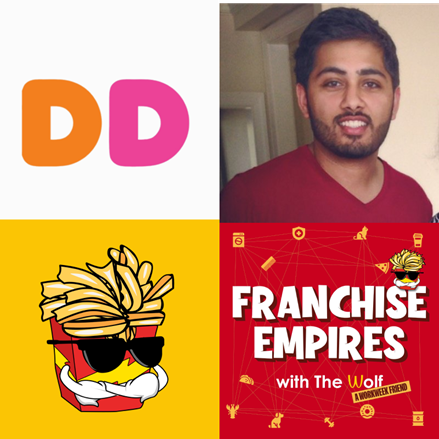🍟 3/10/2022 – Lessons From The Owner of 6 Dunkin’ Donuts
MEET A ZEE
Usman Chaudhry: Dunkin’
Usman grew up in an entrepreneurial family that at various times owned restaurants, gas stations, etc.
But when Usman graduated from college, his father wouldn’t let him join the family business right away, so he had to find his own path.
This led him to working with a friend of his who was already involved with Dunkin‘, and the pair opened their first location in 2017. Fast-forward to today, and they have 3 locations open and operating, with another 3 under construction.
Here are my 3 key takeaways from our conversation:
1. Own a business where the most commonly sold product also has the highest margin
This may sound a bit obvious – but when it comes down to it, many businesses aren’t structured like this.
Often times the most commonly sold SKU in a business will be a loss leader to get customers in the door, and then employees will try to upsell you toward the profit center i.e. “would you like fries with that burger?”
For Usman with Dunkin’, people are walking in for his coffee, and as he puts it in our interview:
“For me, the most expensive part of the coffee is the cup”.
His philosophy is that this lessens his dependence on employees to follow through on training + execute on upsells, because customers are directly ordering his biggest money maker  .
.
2. Benefits of Non-Traditional Locations
Out of his current 3 locations, 2 are on a college campus, and the other is in a strip mall. While Usman recommends a new owner to get started with a traditional location, he does enjoy the benefits of non-traditional locations
For his college campus Dunkin’s, they provide something very important: predictable cash flow. Why? Students are a captive audience, and most don’t have the money to have a car and/or drive off campus to buy coffee elsewhere.
That fact, combined with his rent being priced as a percentage of revenue, and it’s fairly easy to predict what his cash flow will be like throughout a normal (non-covid) school year.
3. The Power of Brand
Dunkin’ is an international brand with almost ~13,000 locations in 36+ countries. It’s a massive company worth billions of dollars, and Usman hasn’t been shy about flexing that when he’s negotiating with landlords.
This especially came in handy during covid when a landlord wasn’t being lenient on the rent being charged during initial lockdowns. Since Dunkin’ is a major brand that brings in customers, it can have positive spillover effects for the rest of the tenants in a strip center. Usman used this leverage in his negotiations to get the best possible outcome he could.
The power of Dunkin’s brand is not lost on him, and he’s well aware he only has that advantage because he chose a franchise – his own branded coffee shop simply would not carry the same weight.
—
If you’d like to listen to the conversation with Usman in full, click here!

FRANCHISE OF THE DAY
SPENGA

Fast Facts
Background
- Founded in 2014, franchising since 2015
- Based in Illinois; 52 territories as of 2021
- A fitness studio combining cardio, strength and flexibility into each workout
Fees + Investment
- Royalty: 7% of gross sales
- Brand Fund: 2% of gross sales
- Franchise Fee: $49,500
- Initial investment: $288,605 – $848,994
Financial Performance
- The below information is based on SPENGA’s affiliate outlet in 2019 and 2020
- NCI = Net Cash In, which seems to be a proxy for gross revenue


The Wolf’s Take 
The more I cover fitness concepts, the more I like the margins, and SPENGA is no different. $300k to the bottom line after $723k in revenue is quite impressive.
While they do note in their financials that this doesn’t include the cost for a manager, it’s still a solid return if an owner hired one to manage a location or two.
Beyond the numbers though, this concept differentiates itself via it’s fitness offering. Oftentimes fitness concepts will either focus on 1 key type of workout, and build programs entirely around that:
- Row House –> rowing workouts
- Stride –> treadmill based workouts
- CycleBar –> biking/cycling workouts
- Rumble –> boxing based workouts
I could go on with examples, but you get the point. Beyond the above ones are the general HIIT concepts, popularized by juggernauts like OrangeTheory and F45.
SPENGA however integrates cycling, yoga, and strength workouts into a single 60 minute session that is broken up into 20 minute segments.
From a customer standpoint, that can translate into far less boredom during the workout given the variety, and also a better workout because they’ll continue to push themselves knowing each phase is only 20 minutes.
Between the unit economics, the uniqueness of this concept, and the positive momentum in boutique fitness, this is a great franchise to look into!
Resources
Disclaimer: This Content is for informational purposes only, you should not construe any such information or other material as legal, tax, investment, financial, or other advice. Nothing contained on this site constitutes a solicitation, recommendation, endorsement, or offer to buy or sell any franchises, securities, or other financial instruments in this or in any other jurisdiction in which such solicitation or offer would be unlawful under the franchise and/or securities laws of such jurisdiction.
All Content in this email is information of a general nature and does not address the detailed circumstances of any particular individual or entity. Nothing in the email constitutes professional and/or financial advice, nor does any information in the email constitute a comprehensive or complete statement of the matters discussed or the law relating thereto. You alone assume the sole responsibility of evaluating the merits and risks associated with the use of any information or other Content in this email before making any decisions based on such information or other Content.


